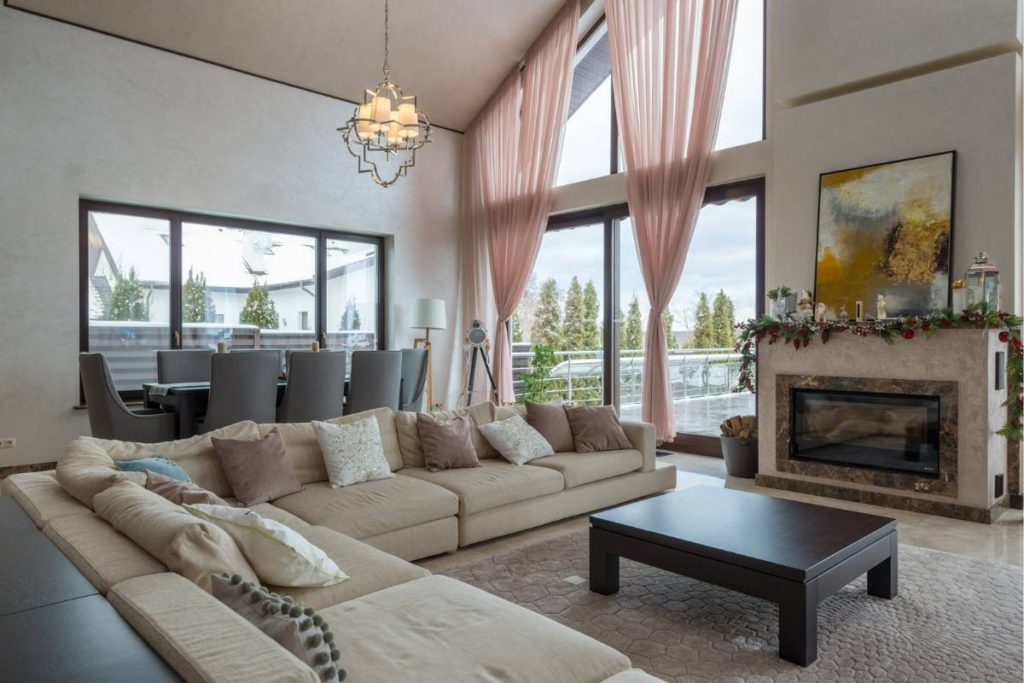How do you balance style and functionality in your home, when you live in an oceanfront home? Is it too hard?
Whether you reside in an oceanfront or waterfront home, it is always exciting. There are endless opportunities to explore, and there is always something different to enjoy when you live near the ocean. Living inside an oceanfront home will be more exciting when you do some designing.
We will share some tips on designing an oceanfront home so that you can balance style and functionality. Let’s get started.
6 Tips to Balance Style and Functionality in Your Oceanfront Home

You need to be innovative, whether you are designing the interior or exterior of any home. For an oceanfront home, you should take your innovation to the next level. For that, take a look at the following 6 tips:
1) Paint the Walls According to the Vibe
Since your house is near the ocean, you need to paint the walls accordingly. Most of the time, people paint their walls blue, which is the right thing to do. You can minimize your color palette by playing with crisp white, light blue, or green.
Go with colors that mostly resemble the coastal design. You can also apply beige shades to give the rooms a sandy feel. If you are confused about the colors, you can get help from many resources (like Pottery Barn) to ensure the perfect combination.
2) Aesthetic Carpeting or Flooring
Carpeting your oceanfront home will not only enhance its look but also keep the original floor clean from dust and sand. There are various types of flooring or carpeting options. However, seagrass or a light texture like sisal can give a unique aesthetic to the space.
You can also go for various rugs made with different materials. Here, you should select something that can mimic the specific home environment. It is like Leigh Spicher‘s (director of Ashton Woods Homes) suggestions,
“Adding a rug to an area that appeals more to a vacation tone than your typical home tone is one of the simplest ways to design a room.”
3) Give a Touch of Wood
While designing an oceanfront home, the layout is the main key. Here, giving the furniture or other components a wooden touch can play a vital role. You can use wood for your dining table, chairs, tables, beds, doors, and other components. Anne Michaelsen (an interior designer) suggests,
“A waterfront residence in Newport Beach’s Balboa Island neighborhood with a contemporary coastal chic design was a favorite project of mine.”
To maintain an airy and light aesthetic, you can go for woods having pale or light shades. Designers don’t like to use dark wood shades because they become overwhelming. You don’t get that light and simple emotion from it.
4) A Cupola Will Add Beauty
A cupola used to be an essential ventilation source. In coastal residences, it has remained an expressive architectural feature. Today, the interior rooms of beachfront homes benefit from natural light flooding through coastal cupolas.
Annapolis-based architect Kathy Purple Cherry installs cupolas to give the coastal and palatial homes on the eastern shore of Maryland a more genuine seaside feel. Hence, you can add one to your oceanfront home to make it unique from the rest.
5) Abstract Arts Can Help
Although it might be appealing to display realistic artwork with an ocean theme, you should try to bring abstract art into your ambiance. To put it simply, you may display pieces that convey the ocean’s mood rather than hanging works of art that depict the sea perfectly. According to an interior designer named Liz Caan,
“As more individuals use their oceanfront second homes more frequently, they’re also appreciating the aesthetic significance to surround themselves with authentic artists.”
When obtained from local artisans, original works not only fill a room with richness and character but also give a provenance of the purchase. A beachfront home feels a million times better real when a lifelong resident creates an acrylic artwork of the surrounding area.
6) Keep Things Minimal
Don’t overthink while designing your oceanfront home; it will only make it worse. Don’t add too much furniture or color. Remember, adding excessive furniture can block or minimize the view of the ocean. Less is good when it comes to balancing the style and functionality of a seaside home.
Meg Young, the Kylienee Coastal founder, advises picking neutral colors for your main items and accessorizing accordingly. Mixing elements and adhering to a neutral color scheme is important to pull off a sleek and weighty design. This enables you to transition between seasons’ worth of accessories with ease.
Tips To Buy an Oceanfront Home

You should remember that purchasing an oceanfront property comes with unique considerations that may not apply to other types of real estate investments. The following overview will provide some essential tips for choosing an oceanfront property and navigating the home-buying process,
Location:
A main consideration when buying an oceanfront home is the location. It has a significant impact on accessibility, safety, scenery, neighborhood, amenities, property value, and so on.
The location of the house also determines the proximity to important places, the type of architecture, the crime rate, and the buying price. A typical waterfront home price in the central point of Ocean City is $1,358,219 (at the time of writing this article). Whereas, you may buy a house in West Ocean City spending of that amount. Although the city is same, we can see a large gap in home values for the location.
Size and Layout:
While buying an oceanfront home, you just can’t ignore the size and layout. This is another important factor to consider since it has an impact on your comfort, functionality, and overall enjoyment.
Think about how many rooms you want depending on the number of family members. Also, think about what type of layout suits the best with your privacy. For instance, Hawaii can be a great place to buy a beachfront home if privacy is a main concern.
Research the Location:
Before purchasing a seaside house, research the location thoroughly. This should be done after considering the location, size, and layout of the house. Make sure the area suits your needs and preferences. This might involve the local climate, nearby amenities, attractions, and the overall vibe of the area.
For example, you want to research the local weather pattern, the overall security, and the proximity to access amenities before buying an oceanfront home in a small beach town in Florida.
Consider Your Budget:
An oceanfront home may come at a higher price. Therefore, you should consider your budget carefully before making an offer. Factors like your current income, your savings and investment accounts, and your long-term financial goal should be taken into account.
Suppose, you want to buy an oceanfront home in California after your retirement. Then, you should save accordingly. At the same time, you should consider property taxes, insurance, maintenance costs, and other financial obligations.
Hire a Real Estate Agent with a Reputation:
When you have made up your mind to buy an oceanfront home after considering your income and other factors, you should look for a qualified real estate agent. Before hiring one, it is wise to ask questions about his experience, rate, and relevant topics based on the local market.
An experienced real estate agent can provide valuable insight and guidance throughout the buying process. For instance, a good agent can help you navigate the unique considerations of an oceanfront home in Malibu, California. These can include insurance requirements and environmental regulations.
Natural Calamities:
The risk of natural calamities can’t be overlooked when you are buying a home near the beach. Natural disasters like hurricanes, flooding, and erosion often strike surrounding areas. Hence, you have to consider factors like house stability, insurance premiums, and the overall cost of ownership.
From previous records, houses located in North Carolina are prone to natural calamities. So, you better research the history of hurricanes, flooding, and coastal management issues before making an offer.
Exterior Maintenance:
An oceanfront home may need extra maintenance due to factors such as saltwater corrosion, sand buildup, and exposure to the elements. Hence, maintaining one can be more challenging than maintaining a home in another location.
Most houses in Maine need additional maintenance for the external area. These include regular painting, sand removal, and storm preparation. You can also hire a property management company to handle maintenance tasks if spending extra bucks is not an issue.
In summary, the aforementioned tips and suggestions will help you keep a balance between the style and functionality of your oceanfront home. If you are still confused about the whole fact, you can consult a home interior designer. In that case, you should have a genuine interest in designing your oceanfront home. Don’t forget to consider the facts described in this article if you don’t own an oceanfront home, but are willing to buy one in the future.











